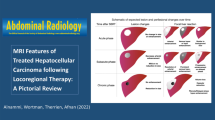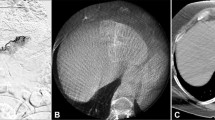Abstract
Transarterial radioembolization is a novel therapy that has gained rapid clinical acceptance for the treatment of hepatocellular carcinoma (HCC). Segmental radioembolization [also termed radiation segmentectomy (RS)] is a technique that can deliver high doses (> 190 Gy) of radiation selectively to the hepatic segment(s) containing the tumor. The aim of this comprehensive review is to provide an illustrative summary of the most relevant imaging findings encountered after radiation segmentectomy. A 62-patient cohort of Child–Pugh A patients with solitary HCC < 5 cm in size was identified. A comprehensive retrospective imaging review was done by interventional radiology staff at our institution. Important imaging findings were reported and illustrated in a descriptive account. For the purposes of completeness, specific patients outside our initial cohort with unique educational imaging features that also underwent segmentectomy were included in this pictorial essay. This review shows that response assessment after RS requires a learning curve with common drawbacks that can lead to false-positive interpretations and secondary unnecessary treatments. It is important to recognize that treatment responses and pathological changes both are time dependent. Findings such as benign geographical enhancement and initial benign pathological enhancement can easily be misinterpreted. Capsular retraction and segmental atrophy are some other examples of unique post-RS response that are not seen in any other treatment.




















Similar content being viewed by others
References
El-Serag HB (2012) Epidemiology of viral hepatitis and hepatocellular carcinoma. Gastroenterology 142(6):1264–1273.e1
Mazzaferro V, et al. (1996) Liver transplantation for the treatment of small hepatocellular carcinomas in patients with cirrhosis. N Engl J Med 334(11):693–699
Padia SA, et al. (2017) Segmental Yttrium-90 radioembolization versus segmental chemoembolization for localized hepatocellular carcinoma: results of a single-center, retrospective, propensity score-matched study. J Vasc Interv Radiol. https://doi.org/10.1016/j.jvir.2017.02.018
Riaz A, et al. (2011) Radiation segmentectomy: a novel approach to increase safety and efficacy of radioembolization. Int J Radiat Oncol Biol Phys 79(1):163–171
Gaba RC, et al. (2009) Radiation lobectomy: preliminary findings of hepatic volumetric response to lobar yttrium-90 radioembolization. Ann Surg Oncol 16(6):1587–1596
Vouche M, et al. (2014) Unresectable solitary hepatocellular carcinoma not amenable to radiofrequency ablation: multicenter radiology-pathology correlation and survival of radiation segmentectomy. Hepatology 60(1):192–201
Salem R, Thurston KG (2006) Radioembolization with 90Yttrium microspheres: a state-of-the-art brachytherapy treatment for primary and secondary liver malignancies. Part 1: Technical and methodologic considerations. J Vasc Interv Radiol 17(8):1251–1278
Nordion M (2004) TheraSphere yttrium-90 microspheres package insert. Kanata: MDS Nordion
Hiatt JR, Gabbay J, Busuttil RW (1994) Surgical anatomy of the hepatic arteries in 1000 cases. Ann Surg 220(1):50–52
Michels NA (1966) Newer anatomy of the liver and its variant blood supply and collateral circulation. Am J Surg 112(3):337–347
Abdelmaksoud MH, et al. (2011) Consolidation of hepatic arterial inflow by embolization of variant hepatic arteries in preparation for yttrium-90 radioembolization. J Vasc Interv Radiol 22(10):1364–1371.e1
Karunanithy N, et al. (2011) Embolization of hepatic arterial branches to simplify hepatic blood flow before yttrium 90 radioembolization: a useful technique in the presence of challenging anatomy. Cardiovasc Intervent Radiol 34(2):287–294
Campbell AM, Bailey IH, Burton MA (2000) Analysis of the distribution of intra-arterial microspheres in human liver following hepatic yttrium-90 microsphere therapy. Phys Med Biol 45(4):1023–1033
Lewandowski RJ, et al. (2007) Radioembolization with 90Y microspheres: angiographic and technical considerations. Cardiovasc Intervent Radiol 30(4):571–592
Louie JD, et al. (2009) Incorporating cone-beam CT into the treatment planning for yttrium-90 radioembolization. J Vasc Interv Radiol 20(5):606–613
Becker C, et al. (2011) C-arm computed tomography compared with positron emission tomography/computed tomography for treatment planning before radioembolization. Cardiovasc Intervent Radiol 34(3):550–556
Virmani S, et al. (2007) Effect of C-arm angiographic CT on transcatheter arterial chemoembolization of liver tumors. J Vasc Interv Radiol 18(10):1305–1309
Wallace MJ, et al. (2007) Impact of C-arm CT on hepatic arterial interventions for hepatic malignancies. J Vasc Interv Radiol 18(12):1500–1507
Boas FE, et al. (2015) Optimal imaging surveillance schedules after liver-directed therapy for hepatocellular carcinoma. J Vasc Interv Radiol 26(1):69–73
Gaba RC, et al. (2015) Clinical and imaging follow-up practices after transarterial therapy for primary and secondary hepatic malignancies. Acad Radiol 22(12):1510–1515
Gaba RC (2012) Chemoembolization practice patterns and technical methods among interventional radiologists: results of an online survey. Am J Roentgenol 198(3):692–699
Bruix J, Sherman M (2011) Management of hepatocellular carcinoma: an update. Hepatology 53(3):1020–1022
European Association for Study of Liver; European Organisation for Research and Treatment of Cancer (2012) EASL-EORTC clinical practice guidelines: management of hepatocellular carcinoma. J Hepatol 56(4):908–943
Bruix J, et al. (2001) Clinical management of hepatocellular carcinoma. Conclusions of the Barcelona-2000 EASL conference. European Association for the Study of the Liver. J Hepatol 35(3):421–430
Organization, W.H. (1979) WHO Handbook for Reporting Results of Cancer Treatment. Geneva: WHO
Lencioni R, Llovet JM (2010) Modified RECIST (mRECIST) assessment for hepatocellular carcinoma. Semin Liver Dis 30(1):52–60
Memon K, et al. (2011) Radiographic response to locoregional therapy in hepatocellular carcinoma predicts patient survival times. Gastroenterology 141(2):526–35, 535.e1–2
Jung ES, et al. (2013) Comparison of the methods for tumor response assessment in patients with hepatocellular carcinoma undergoing transarterial chemoembolization. J Hepatol 58(6):1181–1187
Gillmore R, et al. (2011) EASL and mRECIST responses are independent prognostic factors for survival in hepatocellular cancer patients treated with transarterial embolization. J Hepatol 55(6):1309–1316
Kulik LM, et al. (2006) Yttrium-90 microspheres (TheraSphere) treatment of unresectable hepatocellular carcinoma: downstaging to resection, RFA and bridge to transplantation. J Surg Oncol 94(7):572–586
Sangro B, et al. (2006) Radioembolization using 90Y-resin microspheres for patients with advanced hepatocellular carcinoma. Int J Radiat Oncol Biol Phys 66(3):792–800
Salem R, et al. (2005) Treatment of unresectable hepatocellular carcinoma with use of 90Y microspheres (TheraSphere): safety, tumor response, and survival. J Vasc Interv Radiol 16(12):1627–1639
Kulik LM, et al. (2008) Safety and efficacy of 90Y radiotherapy for hepatocellular carcinoma with and without portal vein thrombosis. Hepatology 47(1):71–81
Tirumani SH, et al. (2014) Update on the role of imaging in management of metastatic colorectal cancer. Radiographics 34(7):1908–1928
Keppke AL, et al. (2007) Imaging of hepatocellular carcinoma after treatment with yttrium-90 microspheres. AJR Am J Roentgenol 188(3):768–775
Camacho JC, et al. (2015) (90)Y radioembolization: multimodality imaging pattern approach with angiographic correlation for optimized target therapy delivery. Radiographics 35(5):1602–1618
Riaz A, et al. (2009) Radiologic-pathologic correlation of hepatocellular carcinoma treated with internal radiation using yttrium-90 microspheres. Hepatology 49(4):1185–1193
Bester L, et al. (2011) Imaging characteristics following 90yttrium microsphere treatment for unresectable liver cancer. J Med Imaging Radiat Oncol 55(2):111–118
Atassi B, et al. (2008) Multimodality imaging following 90Y radioembolization: a comprehensive review and pictorial essay. Radiographics 28(1):81–99
Kallini JR, et al. (2016) Hepatic imaging following intra-arterial embolotherapy. Abdom Radiol (NY) 41(4):600–616
Minocha J, Lewandowski RJ (2015) Assessing imaging response to therapy. Radiol Clin North Am 53(5):1077–1088
Ibrahim SM, et al. (2009) Radiologic findings following Y90 radioembolization for primary liver malignancies. Abdom Imaging 34(5):566–581
Memon K, et al. (2012) Alpha-fetoprotein response correlates with EASL response and survival in solitary hepatocellular carcinoma treated with transarterial therapies: a subgroup analysis. J Hepatol 56(5):1112–1120
Author information
Authors and Affiliations
Contributions
Study concept and design: Ronald A Mora, Rehan Ali, Ahmed Gabr, Nadine Abouchaleh, Ali Al Asadi, Joseph Ralph Kallini, Ahsun Riaz, Robert J Lewandowski, Riad Salem. Acquisition of data: Ronald A Mora, Rehan Ali, Ahmed Gabr, Nadine Abouchaleh, Ali Al Asadi, Ahsun Riaz, Robert J Lewandowski, Riad Salem. Analysis and interpretation of data: Ronald A Mora, Rehan Ali, Ahmed Gabr, Nadine Abouchaleh, Ali Al Asadi, Ahsun Riaz, Robert J Lewandowski, Riad Salem. Drafting of the manuscript: Ronald A Mora, Rehan Ali, Ahmed Gabr, Nadine Abouchaleh, Ali Al Asadi, Joseph Ralph Kallini, Ahsun Riaz, Robert J Lewandowski, Riad Salem. Critical revision of the manuscript for important intellectual content: All Authors. Statistical analysis: Ronald A Mora, Rehan Ali, Ahmed Gabr, Nadine Abouchaleh, Ali Al Asadi, Ahsun Riaz, Robert J Lewandowski, Riad Salem. Administrative, technical, or material support: Ronald A Mora, Rehan Ali, Ahmed Gabr, Nadine Abouchaleh, Ali Al Asadi, Ahsun Riaz, Robert J Lewandowski, Riad Salem. Study supervision: Ronald A Mora, Rehan Ali, Ahmed Gabr, Nadine Abouchaleh, Ali Al Asadi, Joseph Ralph Kallini, Ahsun Riaz, Robert J Lewandowski, Riad Salem.
Corresponding author
Ethics declarations
Conflict of interest
RJL and RS are advisors to BTG. None of the other co-authors report any conflict of interest.
Ethical Compliance
The study was Health Insurance Portability and Accountability Act compliant. All procedures performed were in accordance with the ethical standards of the institutional research committee and with the 1964 Helsinki declaration and its later amendments.
Informed consent was obtained from all individual participants included in the study.
No funding was obtained for this study.
No studies were performed on animal subjects by any of the authors.
Rights and permissions
About this article
Cite this article
Mora, R.A., Ali, R., Gabr, A. et al. Pictorial essay: imaging findings following Y90 radiation segmentectomy for hepatocellular carcinoma. Abdom Radiol 43, 1723–1738 (2018). https://doi.org/10.1007/s00261-017-1391-1
Published:
Issue Date:
DOI: https://doi.org/10.1007/s00261-017-1391-1




